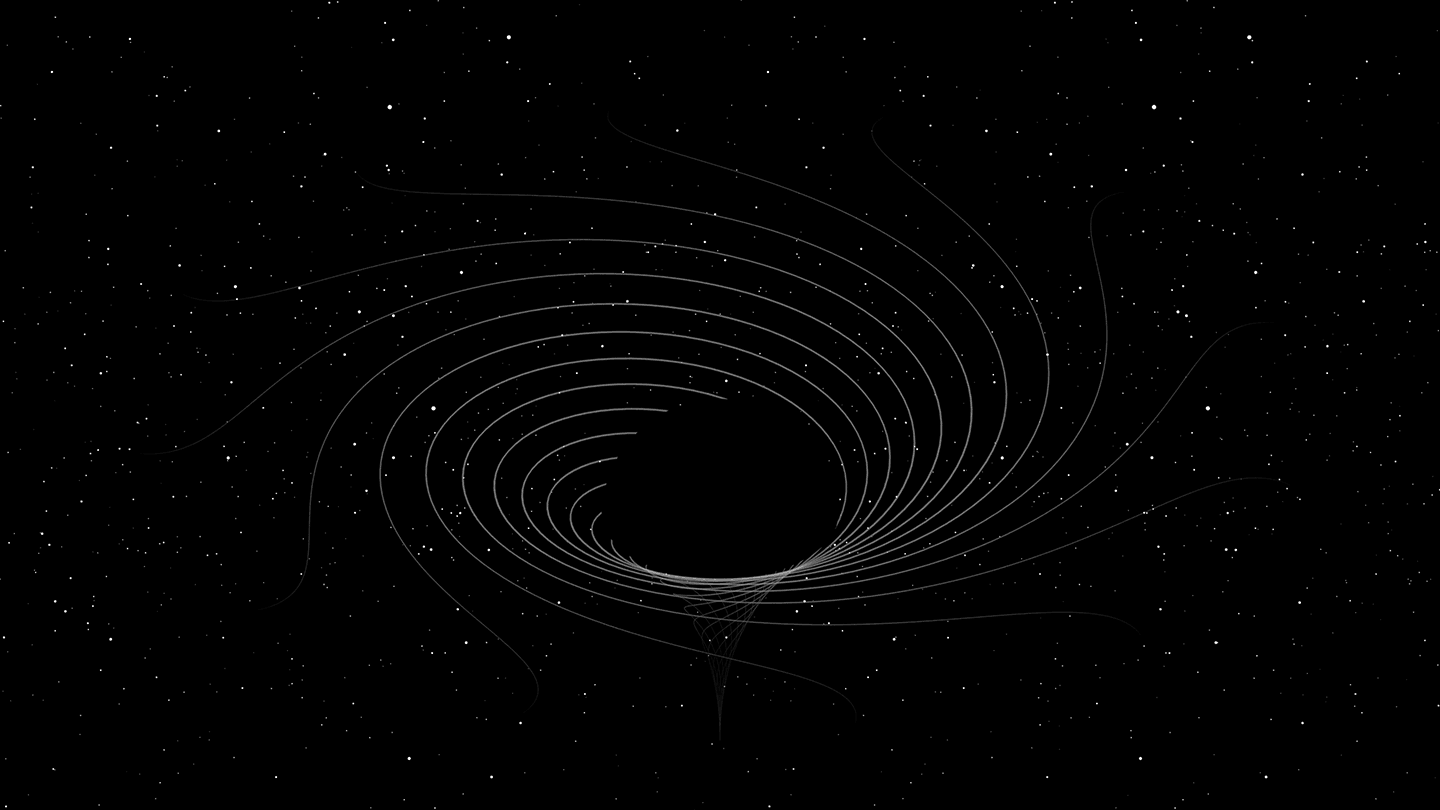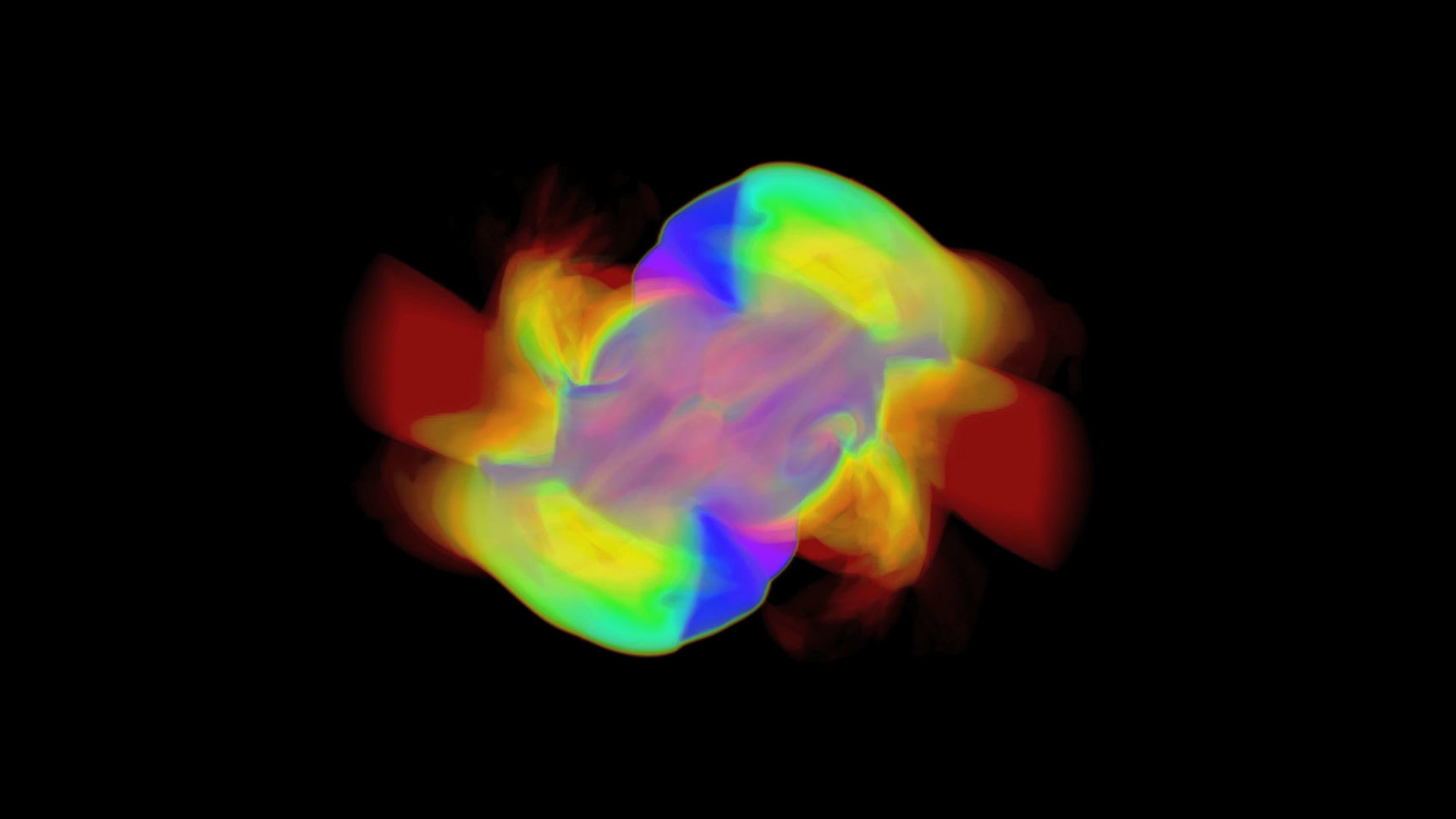Star-Swallowing Black Holes Reveal Secrets in Exotic Light Shows

DVDP for Quanta Magazine
Introduction
Black holes, befitting their name and general vibe, are hard to find and harder to study. You can eavesdrop on small ones from the gravitational waves that echo through space when they collide — but that technique is new, and still rare. You can produce laborious maps of stars flitting around the black hole at the center of the Milky Way or nearby galaxies. Or you can watch them gulp down gas clouds, which emit radiation as they fall.
Now researchers have a new option. They’ve begun corralling ultrabright flashes called tidal disruption events (TDEs), which occur when a large black hole seizes a passing star, shreds it in two and devours much of it with the appetite of a bear snagging a salmon. “To me, it’s sort of like science fiction,” said Enrico Ramirez-Ruiz, an astrophysicist at University of California, Santa Cruz, and the Niels Bohr Institute.
During the past few years, though, the study of TDEs has transformed from science fiction to a sleepy cottage industry, and now into something more like a bustling tech startup.
Automated wide-field telescopes that can pan across thousands of galaxies each night have uncovered about two dozen TDEs. Included in these discoveries are some bizarre and long-sought members of the TDE zoo. In June, a study in the journal Nature Astronomy described an outburst of X-ray light in a cluster of faraway stars that astronomers interpreted as a midsized black hole swallowing a star. That same month, another group announced in Science that they had discovered what may be brightest ever TDE, one that illuminated faint gas at the heart of a pair of merging galaxies.
These discoveries have taken place as our understanding of what’s really happening during a TDE comes into sharper focus. At the end of May, a group of astrophysicists proposed a new theoretical model for how TDEs work. The model can explain why different TDEs can appear to behave differently, even though the underlying physics is presumably the same.
Astronomers hope that decoding these exotic light shows will let them conduct a black hole census. Tidal disruptions expose the masses, spins and sheer numbers of black holes in the universe, the vast majority of which would be otherwise invisible. Theorists are hungry, for example, to see if TDEs might unveil any intermediate-mass black holes with weights between the two known black hole classes: star-size black holes that weigh a few times more than the sun, and the million- and billion-solar-mass behemoths that haunt the cores of galaxies. The Nature Astronomy paper claims they may already have.
Researchers have also started to use TDEs to probe the fundamental physics of black holes. They can be used to test whether black holes always have event horizons — curtains beyond which nothing can return — as Einstein’s theory of general relativity predicts.
Meanwhile, many more observations are on the way. The rate of new TDEs, now about one or two per year, could jump up by an order of magnitude even by the end of this year because of the Zwicky Transient Facility, which started scanning the sky over California’s Palomar Observatory in March. And with the addition of planned observatories, it may increase perhaps another order of magnitude in the years to come.
“The field has really blossomed,” said Suvi Gezari at the University of Maryland, one of the few stubborn pioneers who staked their careers on TDEs during leaner years. She now leads the Zwicky Transient Facility’s TDE-hunting team, which has already snagged unpublished candidates in its opening months, she said. “Now people are really digging in.”
Searching for Star-Taffy
In 1975, the British physicist Jack Hills first dreamed up a black-hole-eats-star scenario as a way to explain what powers quasars — superbright points of light from the distant universe. (Quasars are now known to be supermassive black holes feeding on surrounding gas, not stars.) But in 1988, the British cosmologist Martin Rees realized that black holes snacking on a star would exhibit a sharp flare, not a steady glow. Looking for such flares could let astronomers find and study the black holes themselves, he argued.
Nothing that fit the bill turned up until the late 1990s. That’s when Stefanie Komossa, at the time a graduate student at the Max Planck Institute for Extraterrestrial Physics in Garching, Germany, found massive X-ray flares from the centers of distant galaxies that brightened and dimmed according to the Rees predictions.
The astronomical community responded to these discoveries — based on just a few data points — with caution. Then in the mid-2000s, Gezari, then beginning a postdoc at the California Institute of Technology, searched for and discovered her own handful of TDE candidates. She looked for flashes of ultraviolet light, not X-rays as Komossa had. “In the old days,” Gezari said, “I was just trying to convince people that any of our discoveries were actually due to a tidal disruption.”
Soon, though, she had something to sway even the doubters. In 2010, Gezari discovered an especially clear flare, rising and falling as modelers predicted. She published it in Nature in 2012, catching other astronomers’ attention. In the years since, large surveys in optical light, sifting through the sky for changes in brightness, have taken over the hunt. And like Komossa’s and Gezari’s TDEs, which had both been fished out of missions designed to look for other things, the newest batch showed up as bycatch. “It was, oh, why didn’t we think about looking for these?” said Christopher Kochanek, an astrophysicist at Ohio State University who works on a project designed to search for supernovas.
Now, with a growing number of TDEs in hand, astrophysicists are within arm’s reach of Rees’s original goal: pinpointing and studying gargantuan black holes. But they still need to learn to interpret these events, divining their basic physics. Unexpectedly, the known TDEs fall into separate classes. Some seem to emit mostly ultraviolet and optical light, as if from gas heated to tens of thousands of degrees. Others glow fiercely with X-rays, suggesting temperatures an order of magnitude higher. Yet presumably they all have the same basic physical root.
To be disrupted, an unlucky star must venture close enough to a black hole that gravitational tides exceed the internal gravity that binds the star together. In other words, the difference in the black hole’s gravitational pull on the near and far sides of the star, along with the inertial pull as the star swings around the black hole, stretches the star out into a stream. “Basically it spaghettifies,” said James Guillochon, an astrophysicist at the Harvard-Smithsonian Center for Astrophysics.
The outer half of the star escapes away into space. But the inner half — that dense stream of star-taffy — swirls into the black hole, heating up and releasing huge sums of energy that radiate across the universe.
With this general mechanism understood, researchers had trouble understanding why individual TDEs can look so distinct. One longstanding idea appeals to different phases of the star-eating process. As the star flesh gets initially torn away and stretched into a stream, it might ricochet around the black hole and slam into its own tail. This process might heat the tail up to ultraviolet-producing temperatures— but not hotter. Then later — after a few months or a year — the star would settle into an accretion disk, a fat bagel of spinning gas that theories predict should be hot enough to emit X-rays.
But there’s another option, argued a team led by Jane Lixin Dai at the Niels Bohr Institute and including Ramirez-Ruiz in May. According to their simulations, which include the effects of general relativity, the two kinds of TDEs might just be the same thing seen at different angles. If astronomers are viewing a bagel-like accretion disk from the top, they can see X-rays from the hot inner material swirling right down the drain. When the accretion disk is edge-on, though, colder gas stands in the way. This gas catches X-rays and reemits them as ultraviolet light.
Ultimately, theorists hope to read each event as a variation on the same core theme — and then do deeper science. “Maybe we’ll learn something fundamental about accretion,” Kochanek said. Or maybe “every one will be sufficiently idiosyncratic that it will be like worrying about the shape of a cloud.”
Testing Einstein
The newly discovered TDEs are also helping astronomers to understand supermassive, galaxy-ruling black holes. Only about 10 percent of these giants emit radiation as they feed on surrounding gas, leaving the other 90 percent of them invisible.
TDEs change that. Komossa, an astronomer at the Max Planck Institute for Radio Astronomy in Bonn, hopes to find more binary supermassive black holes: black holes forced to cohabitate after their own galaxies collided, which future space-based gravitational wave experiments will also search for. As a star drains into one black hole, the presence of another supermassive maw nearby would tug at the stream of matter falling in. Instead of a smooth dimming, the TDE would exhibit dips and rises.
Other teams want to test a fundamental, eerie correlation. Somehow the masses of central black holes and their host galaxies seem to increase in tandem. “The mass of the black hole knows about the mass of the galaxy, which is kind of mesmerizing,” Ramirez-Ruiz said. TDEs, plumbing black hole masses in an independent sample of galaxies, could either strengthen or weaken this relationship.
TDEs can also reveal an oxymoronic population: the shrimpiest massive black holes around. While the very biggest known black holes can weigh 10 billion times the sun, and galaxies like the Milky Way host specimens that tip the scales at millions of solar masses, it isn’t clear whether smaller dwarf galaxies are ruled by proportionally pipsqueak versions, in the hundreds of thousands of solar masses or below.
Spotting TDEs from these intermediate mass black holes would settle the question, helping astronomers understand how giant black holes form in the first place. The June paper in Nature Astronomy claims to have found such an intermediate object, one weighing a few tens of thousands of solar masses. That event appeared in 2003, peaked in 2006 and then declined for the following decade. Instead of happening at the center of a galaxy, the X-ray flare occurred in a star cluster, a place where intermediate-mass black holes could coalesce from the mergers of stars. But a single event does not a population make. “We need to find more similar events, to confirm our result,” said Dacheng Lin, an astrophysicist at the University of New Hampshire who led the study.
Then come still deeper goals. TDEs are also starting to test general relativity’s picture of black holes, probing for places where the theory might break.
For example, as a black hole increases in mass, its predicted event horizon creeps steadily outward. But the radius at which the black hole’s tides can crack open a star increases more slowly. At a theoretical limit called the Hills mass, about 100 million times the mass of the sun, a black hole’s star-tearing radius exactly matches its own border. That should put a mass cap on TDEs. “Below that, you can tear something apart. Above that, stars get swallowed hole,” said Nicholas Stone, a theoretical astrophysicist at Columbia University.
So far, the data matches this idea. The rise and fall of known TDEs — already as reliable at weighing supermassive black holes as other techniques — show they all happened around black holes that weigh less than the Hills mass, suggesting that heavier objects likely do have the event horizons that relativity predicts.
But Stone and colleagues are eager to exploit an additional wrinkle. A spinning black hole that weighs 10 times above the Hills mass can still swallow stars. Eventually, after discovering more TDEs, astronomers can watch how the rate of events fades off at high mass, which should help them understand the fastest black hole spins, Stone said.
That might put relativity’s idea of event horizons right back in the crosshairs. A rotating black hole has a theoretical maximum speed, and any black holes seen spinning faster would violate the idea that a black hole has a firm outer boundary.
Thankfully, the observational grist needed to test these various ideas is already on its way. In a dramatic reversal of the field’s beginnings, the new Zwicky Transient Facility is now turning up too many candidates for comfort, Gezari said. She’s starting to strain her resources, trying to get enough telescope time for follow-up observations on each worthy target.
The next leaps come soon. A long-delayed joint German-Russian mission called eRosita, if it goes up in 2019 as planned, should spot hundreds or thousands of TDEs as X-ray flashes. So should the Einstein Probe, a Chinese mission that Komossa collaborates on, scheduled to launch in 2022. And then there’s the Large Synoptic Survey Telescope, currently being built in Chile and scheduled to start scanning the sky in 2022, which should catch its own hundreds or thousands of TDEs among whatever else goes bump in the night.
For Ramirez-Ruiz, this growth since the field’s humble beginnings is a natural consequence of modern “celestial cinematography” — telescopes that shoot night-by-night time-lapse video across the entire sky. TDEs only happen about once every 10,000 years in a given galaxy, when an unlucky star wanders close enough to a black hole. But now that we monitor enough galaxies at once, he said, “the field actually has exploded.”
This article was reprinted on Wired.com.




